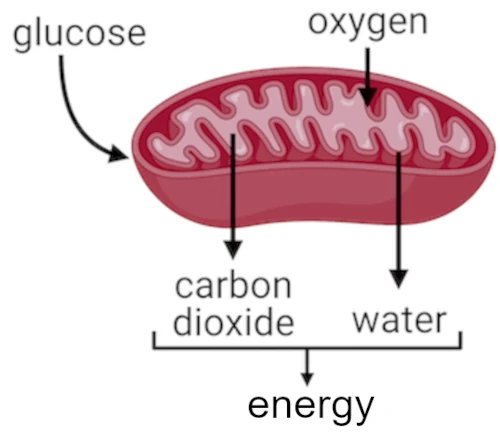
The appearance of oxygen in the Earth's atmosphere about 2.4 billion years ago (Great Oxidation) allowed the selection and development of specialized cellular structures and multicellular organisms. The energy efficiency offered by aerobic respiration (which uses oxygen) made this development possible.
Dioxygen (O₂), the molecular form of gaseous oxygen that we breathe, is indispensable to most living organisms because it plays a central role in the production of cellular energy. This process, called Aerobic Cellular Respiration, takes place mainly in the mitochondria of eukaryotic cells.
Without oxygen, our cells could not efficiently produce ATP (adenosine triphosphate), the universal energy molecule that powers all biological functions.
Oxygen is the final electron acceptor in the electron transport chain located in the inner membrane of the mitochondria. Oxygen thus acts as the final electron acceptor in the respiratory chain, allowing the production of energy from molecules of Adenosine Triphosphate (ATP).
The production of ATP (C₁₀H₁₆N₅O₁₃P₃) from glucose (C₆H₁₂O₆) and dioxygen (O₂) is a complex process called aerobic cellular respiration (30-38 ATP produced by glycolysis). Without oxygen, the energy yield drops considerably (only 2 ATP per glycolysis).
This transformation is the key to the energy metabolism of aerobic organisms!
Glucose (C₆H₁₂O₆) is a chemical structure rich in electrons (12 oxidizable C-H bonds). During their metabolic degradation, the bonds of glucose are broken, easily releasing electrons for an acceptor like oxygen.
The electrons transferred to oxygen (O₂), via the mitochondrial respiratory chain, generate a proton gradient (H⁺). The flow of H⁺ powers ATP synthase. O₂ ensures the evacuation of e⁻ and the maintenance of the gradient.
ATP (C₁₀H₁₆N₅O₁₃P₃)
| Step | Cellular Location | Reactants / Products | ATP Formed | Reduced Coenzymes | Energy (ΔG, kJ/mol) |
|---|---|---|---|---|---|
| Glycolysis | Cytoplasm | C₆H₁₂O₆ → 2 pyruvates | +2 net (4 formed, 2 consumed) | 2 NADH | ≈ –85 |
| Oxidative Decarboxylation | Mitochondrial Matrix | 2 pyruvates → 2 acetyl-CoA + 2 CO₂ | 0 | 2 NADH | ≈ –60 |
| Krebs Cycle | Mitochondrial Matrix | 2 acetyl-CoA → 4 CO₂ | +2 GTP (≈ ATP) | 6 NADH, 2 FADH₂ | ≈ –150 |
| Respiratory Chain (Oxidative Phosphorylation) | Inner Mitochondrial Membrane | NADH, FADH₂ + O₂ → H₂O | +26 to +34 ATP | NAD⁺, FAD regenerated | ≈ –2575 |
| Total for 1 molecule of glucose | ≈ 30 to 38 ATP | 10 NADH, 2 FADH₂ | ΔG ≈ –2870 kJ/mol | ||
N.B.:
The minus sign in ΔG = –2870 kJ/mol indicates a change in thermodynamic potential, specifically the Gibbs free energy, during the evolution of a chemical system.
Sources : Nelson & Cox (Lehninger, 2021), Berg et al. (Biochemistry, 2019), CRC Handbook (2022), Atkins (2020), NIH ODS (2023).
Oxygen deprivation (hypoxia) quickly leads to cellular dysfunction. After only a few minutes without oxygen, brain cells begin to die, which is why asphyxiation is so rapidly fatal.
Strictly anaerobic multicellular organisms are extremely rare, as most multicellular beings depend on aerobic respiration for their high energy demand. However, a few notable exceptions exist, mainly in extreme oxygen-poor environments, such as Henneguya salminicola (Salmon Parasite), Loricifera (Anoxic ecosystems of the seabed), Deep Sediment Nematodes, Anaerobic Fungi.
| Element | Symbol | Percentage by mass (%) | Physiological role(s) | Class |
|---|---|---|---|---|
| Oxygen | O | 65 | Constituent of water and organic molecules, cellular respiration | Major element |
| Carbon | C | 18 | Base of organic molecules (carbohydrates, lipids, amino acids, DNA) | Major element |
| Hydrogen | H | 10 | Constituent of water, acid-base balance | Major element |
| Nitrogen | N | 3 | Amino acids, proteins, nucleic acids (DNA, RNA) | Major element |
| Calcium | Ca | 1.5 | Bone structure, muscle contraction, cell signaling | Macronutrient |
| Phosphorus | P | 1.0 | ATP, DNA, bones, membrane phospholipids | Macronutrient |
| Potassium | K | 0.35 | Osmotic balance, nerve transmission, muscle contraction | Macronutrient |
| Sulfur | S | 0.25 | Sulfur amino acids (cysteine, methionine), coenzymes | Macronutrient |
| Sodium | Na | 0.15 | Nerve transmission, osmotic pressure, intestinal absorption | Macronutrient |
| Chlorine | Cl | 0.15 | Water balance, gastric hydrochloric acid (HCl) | Macronutrient |
| Magnesium | Mg | 0.05 | Enzymatic cofactor, stabilization of ATP and membranes | Macronutrient |
| Iron | Fe | 0.006 | Hemoglobin, myoglobin, electron transport (cytochromes) | Essential trace element |
| Zinc | Zn | 0.003 | Enzymatic cofactor, immune system, protein synthesis | Essential trace element |
| Copper | Cu | 0.0001 | Redox enzymes, iron transport, energy production | Trace element |
| Iodine | I | 0.00002 | Thyroid hormones (T3, T4) | Trace element |
| Selenium | Se | traces | Antioxidants (glutathione peroxidase), immunity | Trace element |
| Chromium, Manganese, Molybdenum, Cobalt | Cr, Mn, Mo, Co | traces | Various catalytic roles (enzymes) | Trace elements |
Sources : Nelson & Cox (Lehninger, 2021), EFSA (2023), ANSES (2022), NIH Dietary Supplements (2023), CRC Handbook.